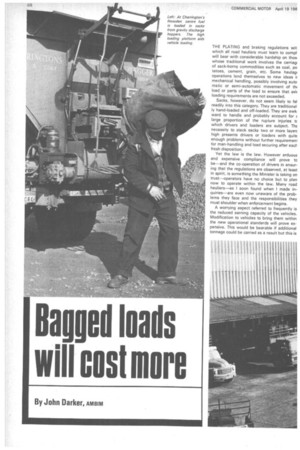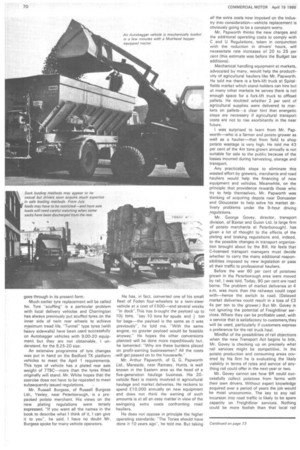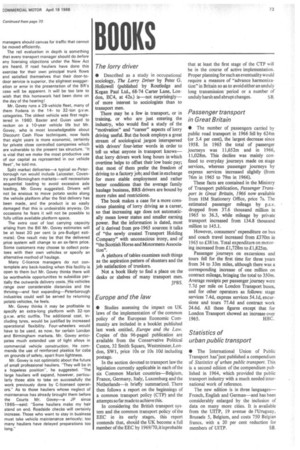PLATING WHAT PENALTIES?
Page 71

Page 70

Page 72

Page 75

If you've noticed an error in this article please click here to report it so we can fix it.
THE PLATING and braking regulations wit] which all road hauliers must learn to compl.
will bear with considerable hardship on thos,
whose traditional work involves the carriagi of sack-borne commodities such as coal, po tatoes, cement, grain, etc. Some haulagi operations lend themselves to new ideas if mechanical handling, possibly involving auto matic or semi-automatic movement of thi load or parts of the load to ensure that axli loading requirements are not exceeded.
Sacks, however, do not seem likely to fal readily into this category. They are traditional ly hand-loaded and off-loaded. They are awk. ward to handle and probably account for z large proportion of the rupture injuries tc which drivers and loaders are subject. The necessity to stack sacks two or more layen high presents drivers or loaders with quite enough problems without further requiremeni for man-handling and load securing after each fresh disposition.
Yet the law is the law. However arduous and expensive compliance will prove to be—and the co-operation of drivers in ensuring that the regulations are observed, at least in spirit, is something the Minister is taking on trust—operators have no choice but to plan now to operate within the law. Many road hauliers—as I soon found when I made inquiries—are even now unaware of the problems they face and the responsibilities they must shoulder when enforcement begins.
A worrying aspect referred to frequently is the reduced earning capacity of the vehicles. Modification to vehicles to bring them within the new operational standards will prove expensive. This would be bearable if additional tonnage could be carried as a result but this is seldom the case. Those—perhaps a minority of hauliers—who have successfully flouted the law for years in operating grossly overloaded vehicles—now face the hard prospect of carrying smaller or lighter loads to comply with the law while appealing to their customers for substantially higher rates.
Charrington Gardner Lockett and Co. Ltd. is one company that has done some homework and is making plans to meet the new challenge to operational safety and efficient distribution methods. Charrington receives coal in bulk at three large rail concentration depots at Neasden, Palace Gate and Chessington. It operates some 27 smaller depots from which many small coal merchants are supplied. All told, they deliver some im tons .of coal a year and it seems clear that the additional costs of implementing the new operating standards will not readily be absorbed within existing margins.
Transport service manager, Mr. G. White, has been following the long series of pronouncements from the Ministry of Transport for several months. A large pile of cuttings from CM bore witness to his industry when I talked to him recently in his Cricklewood office.
Some of his ideas are, he confessed, a little tentative at this stage. For example, he is considering installing fixed centreboards down vehicle platforms to simplify the drivers' task in segregating sack loads. This idea—common in the days of horse-drawn coal carts—may help to solve the tricky axle loading problem which in domestic coal deliveries is complicated by the multiple drop loads varying from 5cwt to 1 ton.
The problem would be much simpler if all coal supplied was of the same grade. That, of course, is not the position. A typical domestic delivery load could be of several different grades of coal. Charrington's mechanical coal centre at Neasden handles 24 different fuels. Drivers, traditionally, stack the varying types of coal for ease of delivery—large orders are often put on the rear of the platform. Delivery points may be more than 30yd from the road side.
Mr. White and his assistant, Mr. D. Howard, are responsible for operating and maintaining some 400 vehicles used for domestic and industrial coal deliveries in London and Eastern counties. Their fleet includes 82 mechanical discharge and 40 bulk discharge vehicles, Relations with Ministry of Transport engineers are excellent—the firm has sent in a number of vehicles to Ministry testing stations and has valued the condition reports furnished during these "pilot" exercises.
Ninety per cent of the domestic delivery fleet consists of Bedford TK models with 18ft platforms. These have been operational with a maximum payload of 71 tons. This size of vehicle, Mr. White believes, is the largest practicable for domestic coal delivery in the London area, so that any replacement vehicles will have to be of similar configuration.
The TKs are not standard vehicles. Rear axles approved for 18,000113 and heavy duty springs were specified. The vehicles carry 7 tons net weight of coal, usually double banked with 4 tons on the bottom sack layer and 3; tons on top layer. Sacks weigh 1 cwt or 11cwt and a typical load consists of 120 sacks, The Autobag mechanical discharge vehicles normally deliver one type of fuel. If a number of partitions were fitted a mixed fuel load could be carried but this would slow down the operation appreciably.
Mr. White has test-weighed a number of vehicles in several simulated loaded conditions. The worst affected by the new regulations is the 17ft platform-2–type KFS --Autobagger which will suffer a considerable reduction—some 30cwt—in payload. Previously, a slight overload was allowed because it quickly diminished as deliveries were made close to the depot, but after July this will no longer be authorized.
An unresolved problem facing Charrington is the effect of the new regulation on drivers' earning capacity. It seems clear that coal delivery costs must go up markedly. For many carmen—as in Charrington's case—are paid a bonus on tonnage delivered. Extra journeys would seem to be called for to accomplish the same work, if loads are to be restricted—marginally in the case of the platform vehicles but appreciably with the Autobaggers. Recent estimates by the Coal Merchants' Federation suggest that consumers will have to pay from 5s to 7s more per ton if the Transport Bill goes through in its present form.
Much earlier tyre replacement will be called for. Tyre "scuffing" is a particular problem with local delivery vehicles and Charrington has always previously put scuffed tyres on the inner side of twin rear wheels to achieve maximum tread life. "Tunnel" type tyres (with heavy sidewalls) have been used successfully on Autobagger vehicles with 9.00-20 equipment but they are not obtainable. I understand, for the 8.25-20 size.
An extensive programme of tyre changes was put in hand on the Bedford TK platform vehicles to meet the April 1 requirements. This type of vehicle has a plated rear axle weight of 7T8C—more than the tyres fitted originally will stand. Mr. White hopes that the exercise does not have to be repeated to meet subsequently issued regulations. • Mr. Russell Burgess, of Russell Burgess Ltd., Yaxley, near Peterborough, is a prepacked potato merchant. His views on the new plating regulations were tersely expressed. "If you want all the names in the book to describe what I think of it, I can give it to you", he said. I have no doubt Mr. Burgess spoke for many vehicle operators. He has, in fact, converted one of his small fleet of Foden four-wheelers to a twin-steer vehicle at a cost of f500—and several weeks "in dock".This has brought the payload up to 10+ tons, "say 10 tons for spuds and 1, ton for bags—the payload is the same as it was previously", he told me. "With the same engine, no greater payload would be feasible anyway." He hopes the other conversions planned will be done more expeditiously but, he lamented: "Why are these burdens placed on profit-earning businessmen? All the costs .will get passed on to the housewife."
Mr. Arthur Papworth, of G. G. Papworth Ltd., Mereside, near Ramsey, Hunts, is well known in the Eastern area as the head of a five-generation haulage business. His 20vehicle fleet is mainly involved in agricultural haulage and market deliveries. He reckons to spend £10,000 annually on new equipment and does not think the earning of such amounts is at all an easy matter in view of the swingeing extra costs confronting road ha uliers.
He does not oppose in principle the higher operating standards: "The Tories should have done it 10 years ago", he told me. But taking all the extra costs now imposed on the industry into consideration--vehicle replacement is obviously going to be a constant worry.
Mr. Papworth thinks the new charges and the additional operating costs to comply with C and U Regulations, taken in conjunction with the reduction in drivers' hours, will necessitate rate increases of 20 to 25 per cent (this estimate was before the Budget tax additions).
Mechanical handling equipment at markets, advocated by many, would help the productivity of agricultural hauliers like Mr. Papworth. He told roe there is a fork-lift truck at Spitalfields market which stand-holders can hire but at many other markets he serves there is not enough space for a fork-lift truck to offload pallets. He doubted whether 2 per cent of agricultural supplies were delivered to markets on pallets—a clear hint that energetic steps are necessary if agricultural transport costs are not to rise exorbitantly in the near future.
I was surprised to learn from Mr. Papworth—who is a farmer and potato grower as well as a haulier—that from field to shop potato wastage is very high. He told, me 43 per cent of the 4m tons grown annually is not suitable for sale to the public because of the losses incurred during harvesting, storage and transport.
Any practicable steps to eliminate this wasted effort by growers, merchants and road hauliers would help the financing of new equipment and vehicles. Meanwhile, on the principle that providence rewards those who try to help themselves, Mr. Papworth was thinking of acquiring depots near Doncaster and Gloucester to help solve his market delivery problems under the 9-hour driving regulations.
Mr. George Govey, director, transport division, of Baxter and Guion Ltd. (a large firm of potato merchants at Peterborough), has given a lot of thought to the effects of the plating and braking regulations and, indeed, to the possible changes in transport organization brought about by the Bill. He feels that C-licensed transport managers must decide whether to carry the many additional responsibilities imposed by new legislation or pass all their traffic to professional hauliers.
Before the war 60 per cent of potatoes grown in the Peterborough area were moved by rail, I was told, Today, 90 per cent are road borne. The problem of market deliveries at 4 a.m. was more than the railways could cope with—hence the switch to road. (Delayed market deliveries could result in a loss of £3 4s per ton to the grower.) But Mr. Govey is not ignoring the potential of Freightliner services. Where they can be profitably used, with a service that is satisfactory to customers they will be used, particularly if customers express a preference for the rail truck haul.
Mindful of the possibilities of rail objections when the new Transport Act begins to bite, Mr. Govey is checking up on precisely what rail services might be competitive. In the potato production and consuming areas covered by his firm he is evaluating the likely viability in terms of rates and service of anything rail could offer in the next year or two.
Mr. Govey cannot see how BR could successfully collect potatoes from farms with their own drivers. Without expert knowledge acquired over a period of years the job would be most uneconomic. The key to any rail incursion into road traffic is likely to be spare capacity on Freightliner services. Nothing could be more foolish than that local rail managers should canvas for traffic that cannot be moved efficiently.
The rail evaluation in depth is something that every transport manager should do before any licensing objections under the New Act are heard. If road hauliers have done this exercise for their own principal trunk flows and satisfied themselves that their door-todoor service is superior, the slightest exaggeration or error in the presentation of the BR's case will be apparent. It will be too late to wish that this homework had been done on the day of the hearing!
Mr. Govey runs a 29-vehicle fleet, many of them Fodens in the 14to 32-ton g.v.w. categories. The oldest vehicle was first registered in 1960. Baxter and Guion used to reckon on a 10-year vehicle life but Mr. Govey, who is most knowledgeable about Discount Cash Flow techniques, now feels that eight years is more economic, certainly for private close controlled companies which are vulnerable to the present tax structure. "It is vital that we make the most productive use of our capital as represented in our vehicle fleet", he told me.
Split market deliveries—a typical ex-Peterborough run would include Leicester, Coventry and Birmingham markets—will necessitate sequential loading to avoid excessive axle loading, Mr. Govey suggested. Drivers will not be anxious to move potato sacks along the vehicle platform after the first delivery has been made, and the product is so easily damaged that this is undesirable anyway. On occasions he fears it will not be possible to fully utilize available platform space.
The extra cost of lost carrying capacity arising from the Bill Mr. Govey estimates will be at least 20 per cent (a pre-Budget estimate). One result may be that the delivered price system will change to an ex-farm price. Some customers may choose to collect potatoes with their own vehicles or specify an alternative method of haulage.
Many C-licence managers do not contemplate any back-loading when this facility is open to them but Mr. Govey thinks there will be worthwhile opportunities to subsidize partially the outwards delivery costs. His vehicles range over considerable distances and the thriving—and fast expanding—Peterborough industries could well be served by returning potato vehicles, he feels.
Mr. Govey thinks it may be profitable to specify an extra-long platform with 32-ton g.v.w. artic outfits. The additional cost, including tyres, would be justified by increased operational flexibility. Four-wheelers would have to be used, as now, for certain London and Birmingham markets. Mr. Govey anticipates much extended use of light alloys in commercial vehicle construction. He commends the use of reinforced plastics for cabs on grounds of safety, apart from lightness.
Mr. Govey is not optimistic about the future of small professional hauliers. "They will be in a hopeless position", he suggested. "The large hauliers will expand, however, particularly those able to take on successfully the work previously done by C-licensed operators." As to those hauliers whose neglect of maintenance has already brought them before the Courts Mr. Govey—a JP since 1965—said: "Some hauliers make my hair stand on end. Roadside checks will certainly increase. Those who want to stay in business must take vehicle maintenance seriously; too many hauliers have delayed preparations too long."








































































































































